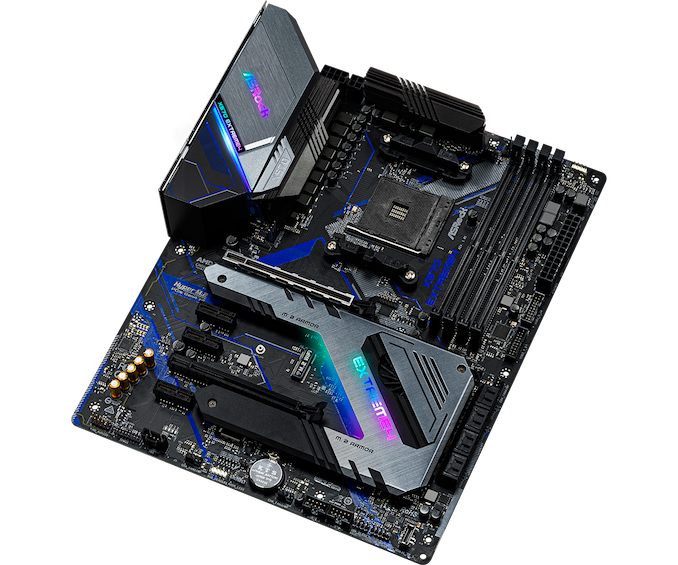The AMD X570 Motherboard Overview: Over 35+ Motherboards Analyzed
by Gavin Bonshor on July 9, 2019 8:00 AM ESTASRock X570 Extreme4
The ASRock X570 Extreme4 is another model which strafes itself away from the more gaming-oriented models from its product stack. Very similar in design and feature set to to the ASRock X570 Steel Legend, the X570 Extreme4 uses a black PCB with darker gunmetal grey colored heatsinks. It also has addressable RGB integrated into the rear panel cover and chipset heatsink, with support for ASRock's Polychrome Sync software.
Looking at the expansion slots available on the ASRock X570 Extreme4, there are two full-length PCIe 4.0 slots with support for x16, and x16/x4 which means up to two way AMD CrossFire is supported; the top full-length slot includes a coating of ASRock's Steel armor for better durability. In addition to this are three PCIe 4.0 x1 slots, and located underneath each of the full-length PCIe 4.0 slots are two PCIe 4.0 x4 M.2 slots, each with an individual heatsink which links into the actively cooled X570 chipset heatsink; also featured is eight SATA ports with RAID 0, 1 and 10 arrays all supported. Underneath the rear panel cover and the heatsinks is a 10-phase power delivery with an 8-pin and 4-pin 12 V ATX CPU power input to power the processor. At the top right-hand corner is four memory slots with support for up to DDR4-4666 and users can install up to a maximum of 64 GB of RAM.
On the rear panel is one USB 3.1 G2 Type-A, one USB 3.1 G2 Type-C and six USB 3.1 G1 Type-A ports, as well as an HDMI video output. While the ASRock X570 Extreme4 doesn't come with Wi-Fi enabled, there is an M.2 Key E 2230 slot for users to install their own wireless interface, and there are mounting holes located on the rear IO shield for this. Also located on the rear panel is a PS/2 combo port, a single Ethernet port controlled by an Intel I211-AT Gigabit NIC, and there are also five 3.5 mm color coded audio jacks and a S/DPIF optical output which are powered by a Realtek ALC1220 HD audio codec.
With a very similar feature set and overall aesthetic to the ASRock X570 Steel Legend model, the X570 Extreme4 features a more modest design with less of a focus on gaming, and more on performance whilst keeping a good quality core feature set. The ASRock X570 Extreme4 has an MSRP of $240, but users in the US can purchase a Wi-Fi 6 enabled version for the slightly higher cost of $250.












225 Comments
View All Comments
abufrejoval - Tuesday, July 9, 2019 - link
It's amazing how quickly you run out of PCIe lanes, when you don't have switches to multiplex and translate between PCIe revisions and lanes (e.g. PCIe v4 x2 <-> PCIe v2 x8).I find myself using USB 3.x NBase-T NICs and NVMe adapters, simply because they *do* switch.
Bensam123 - Tuesday, July 9, 2019 - link
Maybe a bit more depth on the power delivery page. I have absolutely no idea how to go about parsing what's there. More chokes is better? What denotes a power phase?A5 - Tuesday, July 9, 2019 - link
+1. Some analysis of that information would be helpful.MrSpadge - Tuesday, July 9, 2019 - link
+1bunkle - Wednesday, July 10, 2019 - link
The controller column includes the total number of phases supported split between CPU cores and SoC e.g. (6+1) = 6 CPU phase and 1 SoC phase. More is *usually* better but has diminishing returns regarding tighter and tighter voltage regulation. Some controllers are better than others (can operate at high frequency e.g. 500KHz v 1000KHz, include other features to improve performance) mitigating the need for more phases.Each phase is a buck converter comprised of a low/high side MOSFET (can be integrated in a single package) and choke. Some controllers can support doubling up the PWM signal to driver more MOSFETs. Doublers can also be added as discrete components if not built into the controller.
Current rating of the MOSFET (e.g. Sic639=40A IR3555=60A) indicates the total power deliverable. MOSFETs are not 100% efficient and vary in efficiency. The more current they provide the hotter they get and the less efficient they become, with better MOSFETs producing less heat for a given current. Thus using doubles can improve temperatures and efficiency without the benefits of the tighter voltage tolerance that *real* phases provide.
Hope that’s helpful!
bunkle - Wednesday, July 10, 2019 - link
A lot more detailed explanation: https://en.wikichip.org/wiki/voltage_regulator_mod...bug77 - Tuesday, July 9, 2019 - link
The description for AsRock X570(M) Pro4 says "5 jack + 1 SPDIF". Unfortunately, those boards lack SPDIF and only come with 3 jacks ;)Smell This - Tuesday, July 9, 2019 - link
I'm thinking the *ASRock Thunderbolt AIC* ...https://thunderbolttechnology.net/product/asrock-t...
would cover all your TBT peripheral needs, including optical.
DanNeely - Tuesday, July 9, 2019 - link
Do X570 boards still need an extra chip per USB port to support USB-C reversibility?The additional expense and needed PCB space were cited as among the reasons why earlier generation boards (IIRC both Intel and AMD) almost never had more than 1 C port; but it was never clear to me if that was an inherent implementation penalty for the C port or an artifact of Intel's tech stack being stalled out and AMD outsourcing to ASMedia which built the chipsets on an ancient (55nm) platform.
DigitalFreak - Tuesday, July 9, 2019 - link
Gavin - X370 and X470 only supported PCIe 2.0. The connection between the CPU and chipset was 3.0, but all the ports on the chipset were 2.0.